If you’re coming to San Diego to get a taste of its incredible fishing action – go after Tuna! You’ll hardly find a better place on the West Coast to target these ultimate game fish, and out of all of them, Bluefin Tuna fishing in San Diego steals the spotlight.

There’s no exaggeration when we say this is the best place in the country to fish for giant Pacific Bluefin. Yes, you’ll have to travel quite a bit to get to the most productive spots, but you’ll be glad you did. Bluefins are fantastic fighters and provide even better table fare, and having one on the end of the line isn’t for the faint of heart. If everything you’ve read has put a smile on your face, keep going! We’ll help you with everything you need to know before you start your adventure.
Why Pacific Bluefin Tuna?
You won’t find a more prized catch than Pacific Bluefin Tuna along the entire West Coast. They’re the biggest fish you’ll find in these parts and can reach well over 300 pounds. Most of them are smaller, in the 20–50 lb ballpark, but there are plenty in the 100+ lb realm. Their size alone makes Bluefins a challenge to reel in. But that’s just to get you started.

Tuna’s speed and brute strength are important factors when fishing for Tuna. Bluefins are among the most relentless fighters in the world – you’ll need patience, muscles, and skill to get them into the boat. It’s not unorthodox for the battle to last hours before either the fish or the line gives out. That’s why a Tuna hunt is usually recommended for more experienced anglers.
Finally, Bluefin Tuna migration patterns are unpredictable, and finding them is easier said than done. They adapt easily to different water temperatures, so they can change direction as they please. This makes it harder for guides to find them, but there are some signs you can follow which we’ll mention. All this makes a Bluefin Tuna a legendary catch against which every avid angler wants to test their skill.
What is the best month for Bluefin Tuna fishing in San Diego?
Since these fellas are adaptable to different temperatures, you can target Bluefins out of San Diego most of the year. The main season is from April–November, though sometimes you’ll find them around as early as March or as late as December. The hottest bite is usually during the summer.

Your chosen fishing technique will change with the seasons, too. Early on, the optimal method is to use topwater lures because Bluefins feed on the surface. As the days get warmer, methods will change as the fish move to deeper sections of the water column. This is when kite fishing, helium balloon fishing, trolling, and freelining bait give the best results. Night fishing for Tuna is on fire during summer when chumming and chunking make the magic happen.
Where to catch Bluefin Tuna in San Diego?
The waters around San Diego get very deep very quickly, which is great news for offshore anglers. This means you don’t have to go very far out to find your share of Bluefin Tuna, though you’ll mostly find smaller specimens here.
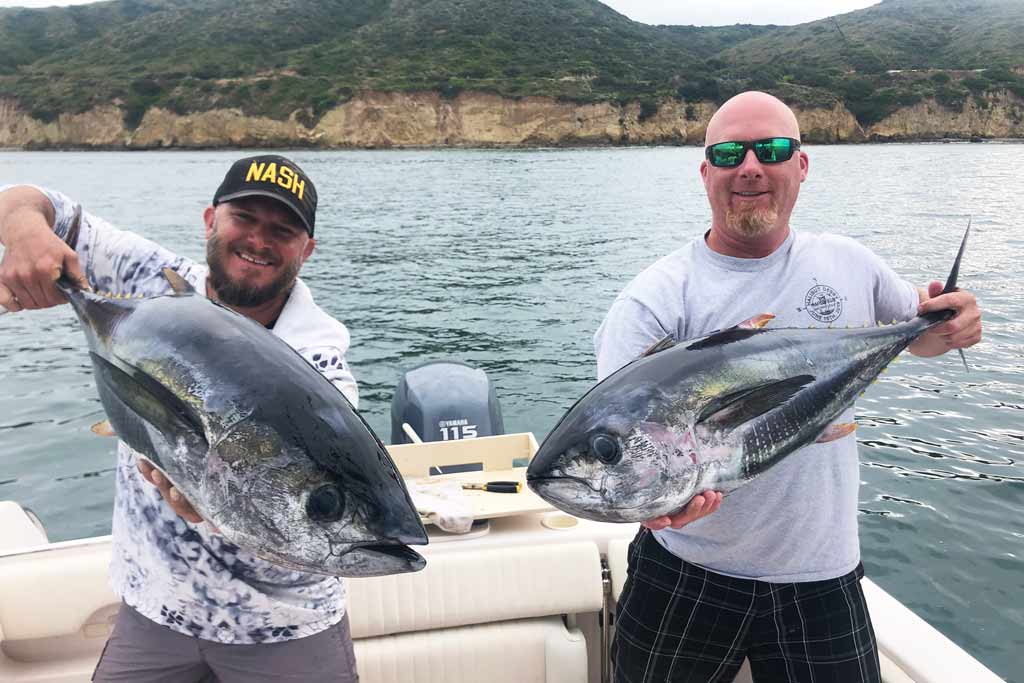
Deep sea trenches are the main Tuna gathering places, as well as drop-offs in the ocean floor – aka banks. There are a number of banks where you can go to chase Bluefins, and local charters know them all.
If you’ve got trophy catches on your mind, head out to the Coronado Islands in the waters of Mexico. True, you’ll need a passport to go there, but there’s some epic Bluefin action happening here.
Other epicenters of Tuna action are the San Clemente and Santa Catalina Islands. They’re further out than the Coronado Islands, but this is where you’ll go for a chance to battle the biggest Bluefin of your life. You’ll want to book a multi-day trip to make this dream a reality, but what an adventure it will be. It’s not just Bluefins that reign supreme here, Yellowfins are very popular in the area as well.
How to catch Bluefin Tuna in San Diego?
There are a few different ways to get a bite when you go Bluefin Tuna fishing in San Diego. Favorite techniques include trolling, kite fishing, chumming, and helium balloon fishing.
It’s important to know that landing a Tuna is no easy feat. Just because you have one on the line does not mean the hardest part is done. These speedsters are escape artists and are known to shake the hook free or cut the line on the edges of the boat by running under it. You’ll need to stay focused and agile as the battle goes on and make sure you outsmart the Bluefin before it outsmarts you.
Trolling
For a lot of anglers, this is the go-to technique for finding and catching Bluefin Tuna. No matter the time of the year, trolling can be productive, especially if you spot Tuna feeding close to the surface. The easiest way to spot them is to look for diving birds and areas with rippling water.
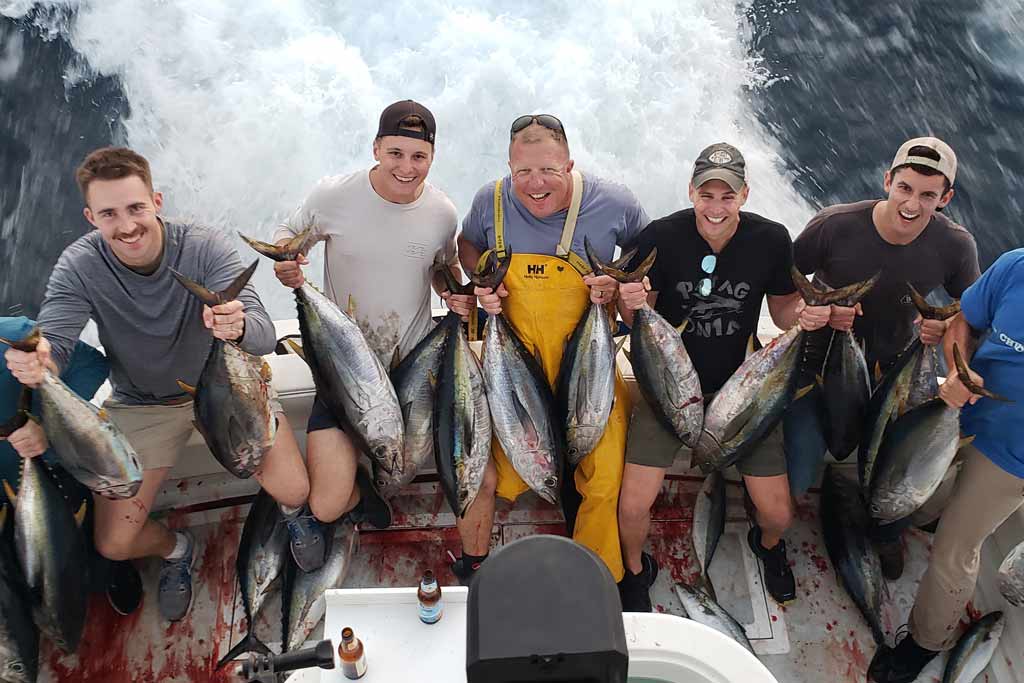
Your trolling speed should be no more than 10 knots, and you can use both live bait or lures. Trolling works very well when paired with chumming. Once you get one Bluefin on the line, chum the waters around the boat to attract other Tuna nearby. This gives you an opportunity to start a feeding frenzy and get multiple hookups.
Once the chum is in the water, you can also try free lining your bait among dead bait floating around. You’ll be able to focus your efforts and cast the bait where you see fish feeding. But, at the same time, your line will be visible in the water – and Tuna have great eyesight. As you can see, trolling is a versatile technique that can be mixed well with others, and your guide will let you know what’s the best combo to go with.
Kite Fishing
Some anglers swear by kite fishing for Tuna and the results you get from using this technique are undeniable. Bluefin and its siblings are no easy prey. As we mentioned, they see exceptionally well. They’re likely to run away as soon as they hear the loud boat engine, and the chances of finding them again are slim. Enter kite fishing.

This technique allows you to suspend your fishing line above the water while keeping the bait in. The setup will be flying far from the boat, which means Bluefins won’t be spooked by the ruckus that a boat can make. So when you use a kite to present your offering to hungry Bluefin, it will look as close to an isolated helpless bait fish as possible.
To get the kite up, the speed of the boat should be up to 10 knots, similar to trolling. You’ll need to use strong gear and a braided line so that when you get a fish on, you can keep it there. Keep in mind that kite fishing requires some expertise and it’s trickier to handle than trolling. Once you get the hang of it though, it might just become your favorite method for Bluefin Tuna fishing in San Diego.
Helium Balloon Fishing
As you might have guessed by now, the trick to getting a Tuna to bite is to remove any spook factor that might get them on the run. Aside from kite fishing, you can also achieve this by using a helium balloon. This technique might be a bit easier to master, while still being very productive.
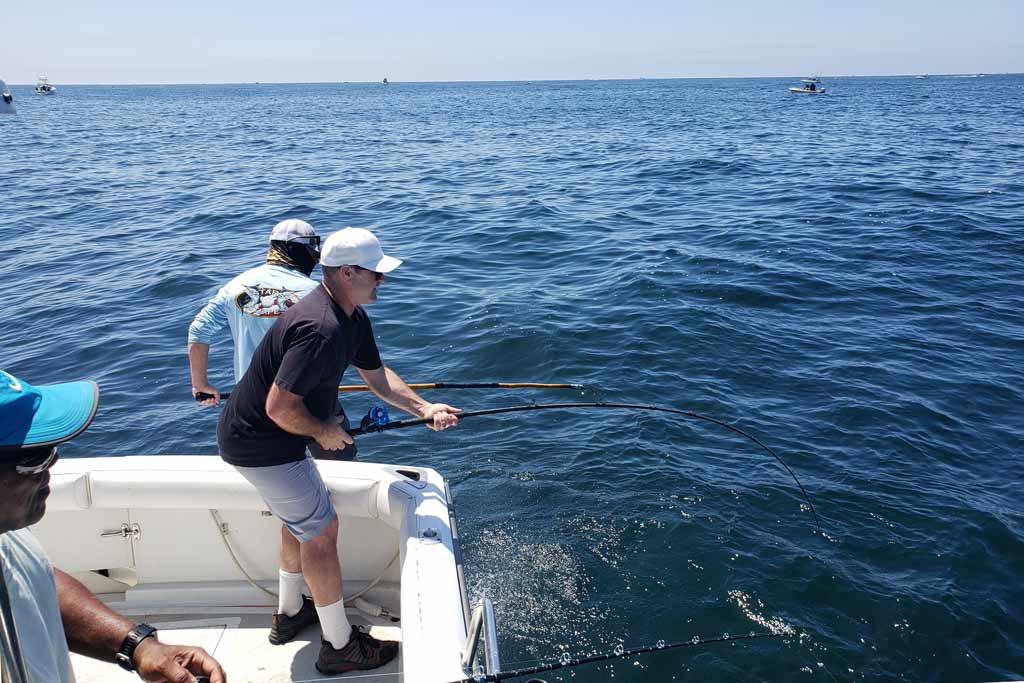
The core of balloon fishing is that you tie the bait that’s on the line to the balloon and let it float. That way, the balloon will regulate the way your setup moves and look more natural to Tuna. The crucial thing to get right is the amount of helium in the balloon because otherwise bait will either sink or float above water. If you overdo it, sinkers will help you with keeping the offering in the water.
The pros of helium balloon fishing are many – your setup is far away from the boat, so Bluefins are more likely to take it. You can also keep an eye on your bait at all times because the balloon will mark exactly where it is. When you spot Tuna on the sonar, you can position the bait fish right above them using the balloon. Bluefins will see it as “easy pickings.” Just be sure to pick latex balloons because they’re more eco-friendly than the standard plastic ones.
Gear and Tackle for Tuna Fishing in San Diego
Tuna give a fast and furious fight when hooked, so you’ll need fishing equipment that can keep up with their demanding pace. Bluefins can swim up to 40 miles per hour and they’ll fight you for every inch of the line. In addition, their headshakes and jumps will only make it harder to keep them on.
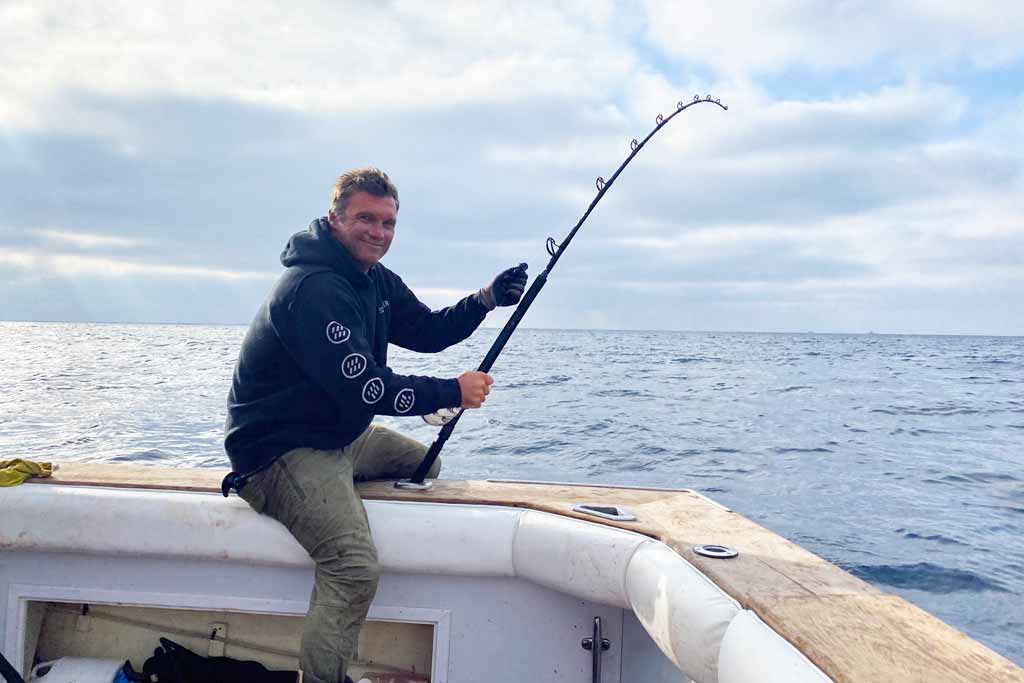
Since Tuna fishing has been nothing short of top-notch in the past few years, you want to go out ready for all scenarios gear-wise. If you plan on targeting smaller fish (up to 70 pounds), 7′ spinning rods, rated up to 80 pounds will do the trick. Pair that with a 5000–6000 spinning reel and a 60–65 lb braided line. Since Tuna are repelled by visible lines in the water, you’ll want to use a 40 lb fluorocarbon leader.
Got your sights on giant Bluefin? The setup can stay similar, but you should up the stakes a little bit. You can still use 7–8′ rods, but they should be rated from 70–130 pounds. You’ll also need a stronger line – at least an 80 lb braid. The leader can stay the same but, if you’re fishing with lures, you can up to an 80 lb leader as well.
When it comes to hook sizes, 3/0–5/0 circle hooks will do the trick. Remember to keep the size of the hook proportionate to the size of your bait. Make sure all your gear is functional and ready to go because Tuna will test it in every possible way.
What bait and lures to use when fishing for Pacific Bluefin Tuna?
Another good thing about Bluefin Tuna fishing in San Diego is that you can land them on a variety of setups. If the timing is good, you can use live bait and artificials with great results.
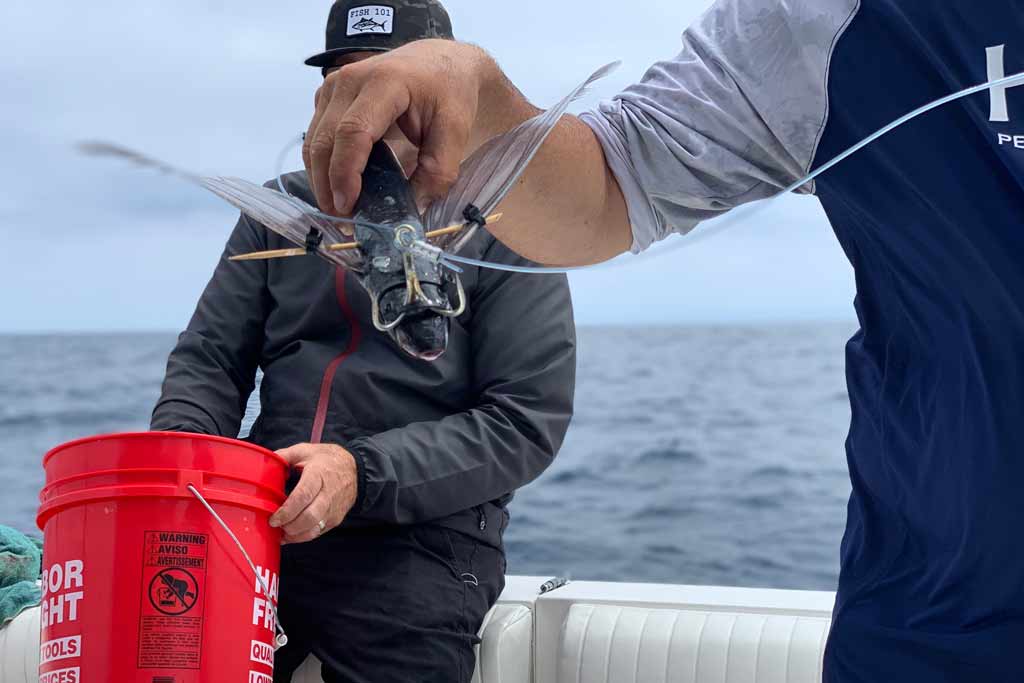
On the live bait side of things, you can do no wrong with anchovies and sardines. If you see a patch of water where anchovies are flying out of the water, that’s where Tuna are feeding, and that’s where your bait needs to be. Flying fish and mackerel can also work well.
There’s also a variety of lures that can get your get you a bite. Bluefins respond well to California Flyers, a flying fish lure that works like a charm, especially for kite fishing. Poppers and stickbaits are also a good way to go, as well as knife, vertical, butterfly-style, and flat fall jigs.
Best Spots for Bluefin Tuna Fishing in San Diego
Now that you know when and how to fish for Pacific Bluefin, let’s take a closer look at the most prolific fishing spots.
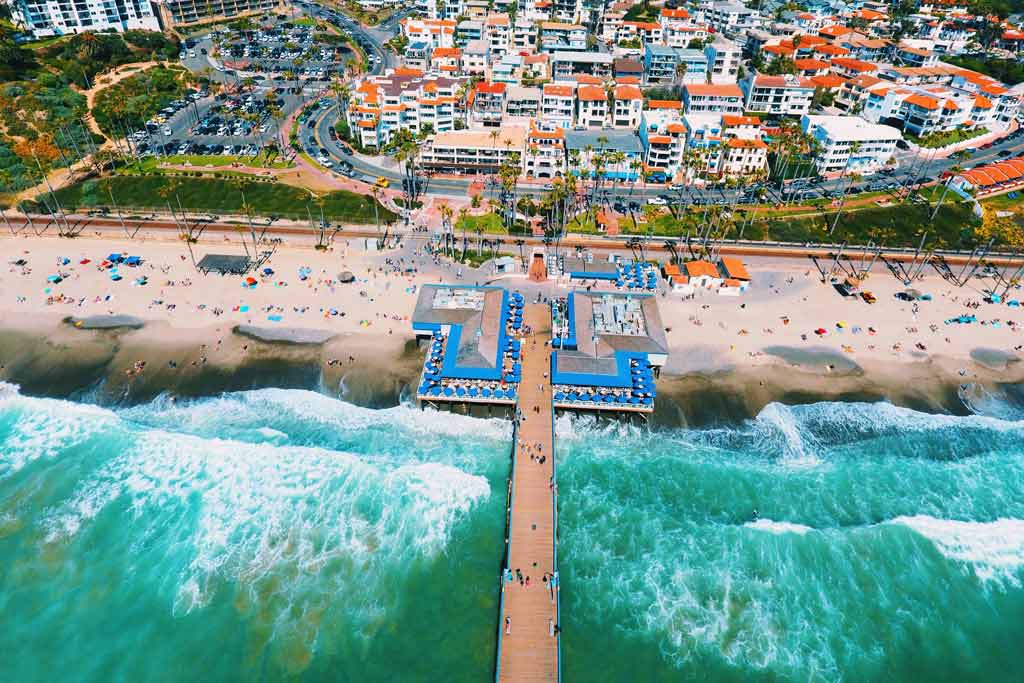
- Santa Catalina and San Clemente Islands. We’re starting off with a couple of classics. These islands are a favorite haunt of Bluefin trophy chasers and for good reason. There are a lot of big specimens swimming in these waters.
- 425 Bank. You’ll find all kinds of Tuna here, not only Bluefin. This is a popular spot for commercial fishermen, so make sure you cast your lines away from their Tuna pens.
- Coronado Islands, Mexico. You’ll have to leave the country for this trip, but this is a show-stopping fishery. There’s a good chance of hooking into massive Bluefin and Yellowfin Tuna.
- Butterfly Bank. This is a butterfly-like formation of seamounts that attract all kinds of offshore predators and bait fish. There’s a lot of Tuna in this area, and it’s almost a fail-safe spot for experienced Tuna lovers. Bluefins are always on the list.
- San Salvador Knoll. If you’re fishing out of San Diego in late fall, this might be your go-to spot. San Salvador Knoll holds good numbers of Bluefin Tuna even in late November, so it’s a no-brainer why it’s one of the top fishing spots.
Bluefin Tuna Fishing in San Diego – A Once-in-a-Lifetime Adventure
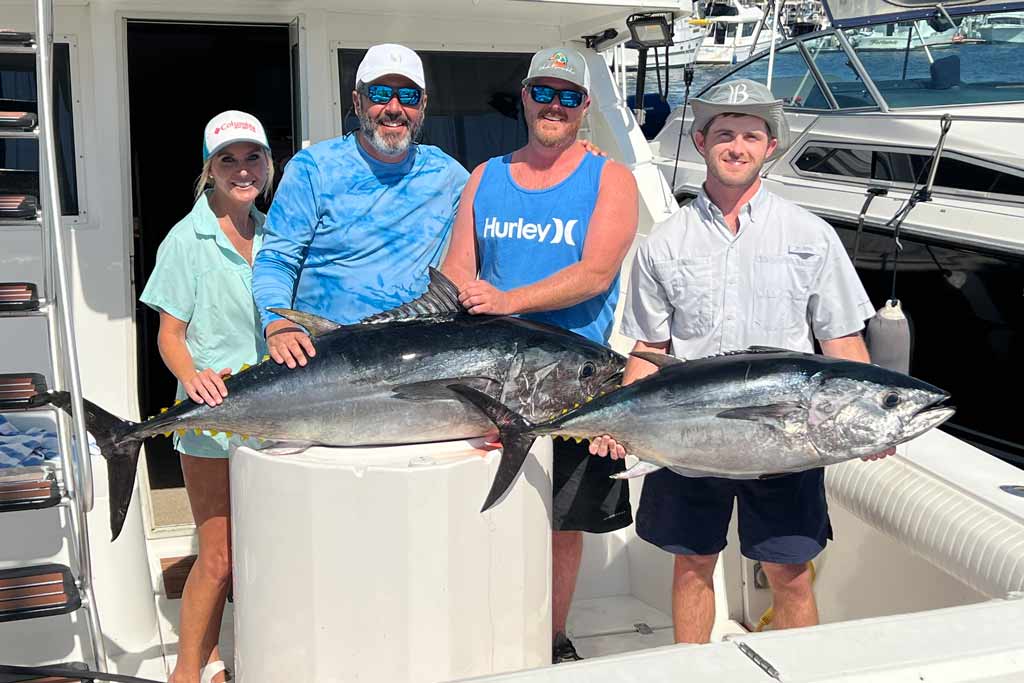
From everything you now know, it’s not hard to understand why Bluefins are such a big deal in San Diego. They’re a crowning achievement in the career of any seasoned angler and, on top of that, they’re absolutely delicious. Getting one on the line isn’t easy and these beauties will challenge you every step of the way. But they’re worth all the effort.
Have you ever been fishing for Bluefin Tuna in San Diego? What’s your experience with these deep sea fighters? Do you have a story or a tip to share? Let us know in the comments below.
The post Bluefin Tuna Fishing in San Diego appeared first on FishingBooker Blog.
https://ift.tt/vj2SJ19
0 Comments
Enregistrer un commentaire